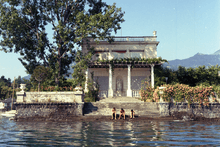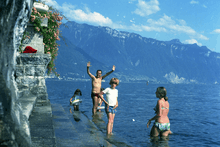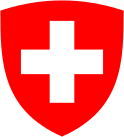Lake Geneva
| Lake Geneva | |
|---|---|
 Satellite image | |
| Location | Switzerland, France |
| Coordinates | 46°26′N 6°33′E / 46.433°N 6.550°ECoordinates: 46°26′N 6°33′E / 46.433°N 6.550°E |
| Primary inflows | Rhône, Dranse |
| Primary outflows | Rhône |
| Catchment area | 7,975 square kilometres (3,079 sq mi) |
| Basin countries | Switzerland, France |
| Max. length | 73 km (45 mi) |
| Max. width | 14 km (8.7 mi) |
| Surface area | 580.03 km2 (224 sq mi) |
| Average depth | 154.4 metres (507 feet) |
| Max. depth | 310 metres (1,020 feet) |
| Water volume | 89 km3 (72,000,000 acre·ft) |
| Residence time | 11.4 years |
| Surface elevation | 372 m (1,220 ft) |
| Islands | Île de Peilz, Château de Chillon, Île de Salagnon, Île de la Harpe, Île Rousseau, Île de Choisi |
| Settlements | Geneva (CH), Lausanne (CH), Evian (F), Montreux (CH), Thonon (F), Vevey (CH) (see list) |
Lake Geneva (French: le lac Léman or le Léman[1] [lə (lak) lemɑ̃], sometimes le lac de Genève [lə lak də ʒ(ə)nɛːv], German: Genfersee [ˈɡɛnfərˌzeː]) is a lake on the north side of the Alps, shared between Switzerland and France. It is one of the largest lakes in Western Europe and the largest on the course of the Rhône. 59.53% (345.31 km2 [133.32 sq mi]) of it comes under the jurisdiction of Switzerland (cantons of Vaud, Geneva, and Valais), and 40.47% (234.71 km2 [90.62 sq mi]) under France (department of Haute-Savoie).
Lake Geneva has been explored by four submarines: the Auguste Piccard and the F.-A. Forel, both built by Jacques Piccard, and the two Mir submersibles.[2]
Name
The first recorded name of the lake is Lacus Lemannus, dated from Roman times; Lemannus comes from Ancient greek Limanos, Liménos Limne Λιμένος Λίμνη meaning port's lake; it became Lacus Lausonius, although this name was also used for a town or district on the lake, Lacus Losanetes and then the Lac de Lausanne in the Middle Ages. Following the rise of Geneva it became Lac de Genève (translated into English as Lake Geneva). In the 18th century, Lac Léman was revived in French and is the customary name in that language. In contemporary English, the name Lake Geneva is predominant. A note on pronunciation:
- English: Lake Geneva /ˌleɪk dʒᵻˈniːvə/
- French: le lac Léman [lə lak leˈmɑ̃] or le Léman [lə leˈmɑ̃]
- German: Genfersee (German Switzerland) or Genfer See (Germany) [ˈɡɛnfər ˈzeː]
- Italian: Lago Lemano, Lago di Ginevra [ˈlaːɡo di dʒiˈnɛːvra].
Geography
Lake Geneva is divided into three parts because of its different forms of formation (sedimentation, tectonic folding, glacial erosion):[1]
- Haut Lac (Upper Lake), the eastern part from the Rhône estuary to the line of Meillerie–Rivaz
- Grand Lac (Large Lake), the largest and deepest basin with the lake's largest width
- Petit Lac (Small Lake), the most south-west, narrower and less deep part from Yvoire–Promenthoux next Prangins to the exit in Geneva
According to the Swiss Federal Office of Topography, swisstopo, Lac de Genève designates that part of the Petit Lac, which lies within the cantonal borders of Geneva (excluding the cantonal exclave Céligny), so about from Versoix–Hermance to the Rhône outflow in Geneva.[3]
The Chablais Alps border is its southern shore, the western Bernese Alps lie over its eastern side. The high summits of Grand Combin and Mont Blanc are visible from some places. Compagnie Générale de Navigation sur le lac Léman (CGN) operates boats on the lake.
The lake lies on the course of the Rhône. The river has its source at the Rhône Glacier near the Grimsel Pass to the east of the lake and flows down through the canton of Valais, entering the lake between Villeneuve and Le Bouveret, before flowing slowly towards its egress at Geneva. Other tributaries are La Dranse, L'Aubonne, La Morges, La Venoge, La Vuachère, and La Veveyse.
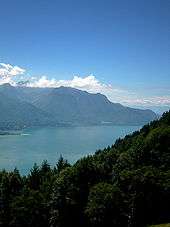
Lake Geneva is the largest body of water in Switzerland, and greatly exceeds in size all others that are connected with the main valleys of the Alps. It is in the shape of a crescent, with the horns pointing south, the northern shore being 95 km (59 mi), the southern shore 72 km (45 mi) in length. The crescent form was more regular in a recent geological period, when the lake extended to Bex, about 18 km (11 mi) south of Villeneuve. The detritus of the Rhône has filled up this portion of the bed of the lake, and it appears that within the historical period the waters extended about 2 km (1.2 mi) beyond the present eastern margin of the lake. The greatest depth of the lake, in the broad portion between Évian-les-Bains and Lausanne, where it is just 13 km (8.1 mi) in width, has been measured as 310 m (1,020 ft), putting the bottom of the lake at 62 m (203 ft) above sea level. The lake's surface is the lowest point of the cantons of Valais and Vaud.[4] The culminating point of the lake's drainage basin is Monte Rosa at 4,634 metres above sea level.[5]
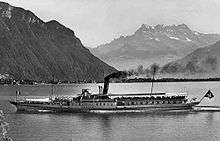
The beauty of the shores of the lake and of the sites of many of the places near its banks has long been celebrated. However, it is only from the eastern end of the lake, between Vevey and Villeneuve, that the scenery assumes an Alpine character. On the south side the mountains of Savoy and Valais are for the most part rugged and sombre, while those of the northern shore fall in gentle vine-covered slopes, thickly set with villages and castles.[4]
The snowy peaks of the Mont Blanc are shut out from the western end of the lake by the Voirons mountain, and from its eastern end by the bolder summits of the Grammont, Cornettes de Bise and Dent d'Oche, but are seen from Geneva, and between Nyon and Morges. From Vevey to Bex, where the lake originally extended, the shores are enclosed by comparatively high and bold mountains, and the vista terminates in the grand portal of the defile of St. Maurice, cleft to a depth of nearly 2,700 m (8,900 ft) between the opposite peaks of the Dents du Midi and the Dent de Morcles.[4]
The shore between Nyon and Lausanne is called La Côte because it is "flatter". Between Lausanne and Vevey it is called Lavaux and is famous for its hilly vineyards.[6][7]
The average surface elevation of 372 m (1,220 ft) above sea level is controlled by the Seujet Dam[8] in Geneva.[9]
Environment
In 563, according to the writings of Gregory of Tours and Marius Aventicensis, a tsunami wave swept along the lake, destroying the fort of Tauredunum and other settlements, and causing numerous deaths in Geneva. Simulations indicate that the Tauredunum event was most likely caused by a massive landslide near the Rhône delta, which caused a wave eight meters high to reach Geneva within 70 minutes.[10][11][12] In 888 the town was part of the new Kingdom of Burgundy, and with it was taken over in 1033 by the German Emperor.
In the late 1960s, pollution made it dangerous to swim at some beaches of the lake; indeed, visibility under water was near zero.[13][14] By the 1980s, intense environmental pollution (eutrophication) had almost wiped out all the fish. Today, pollution levels have been dramatically cut back, and it is again considered safe to swim in the lake.[15][16] Major leisure activities practiced include sailing, wind surfing, boating (including water skiing and wakeboarding), rowing, scuba diving and bathing.
On a scientific footnote, in 1827, Lake Geneva was the site for the first measurement of the speed of sound in (fresh) water.[17] French mathematician Jacques Charles François Sturm and Swiss Physicist Daniel Collodon used two moored boats, separated by a measured distance, as the transmit and receive platforms for the sounds of exploding gunpowder. The loud airborne sound coupled into the lake, establishing a loud underwater sound that could be measured at a distance. The flash of the exploding gunpowder provided the visual starting cue for the timepiece, and the underwater explosion sound striking a bell provided the finish cue.
The lake is rich in wildlife, especially birds: both the common buzzard and the red kite breed here in considerable numbers.
Sport events
Yacht racing is a popular sport, and high-performance catamarans have been developed specifically for the lake.[18] The design of the Alinghi 5, the defender of the 2010 America's Cup, was influenced by those racing catamarans.[18] The best-known event, the "Bol d'Or" (not to be confused with other events having the same name) runs from Geneva to the end of the lake and back.[19]
Also the rowing event Tour du Lac takes place on the lake Geneva. The regatta runs one time around the lake and is at a distance of 160 km (99 mi), the longest non-stop rowing regatta in the world.
Towns and villages
| Southern shore | Northern shore | |
|---|---|---|
| Haut Lac |
Valais (VS): |
Vaud (VD): |
| Grand Lac |
|
Vaud (VD): |
| Petit Lac |
Canton of Geneva (GE): |
Vaud (VD):
Canton of Geneva (GE): |
Notable residents
Mary and Percy Shelley and Lord Byron holidayed by the lake and wrote ghost stories, one of which became the basis for the novel Frankenstein.[20] The Empress Elisabeth of Austria (Sisi) was stabbed to death on the quayside in Geneva in September 1898. Vladimir Lenin rented a little "chalet" at the French bank, near Geneva.[21] Actor Charlie Chaplin spent his final years and died in Vevey (there is a memorial statue of him along the promenade). Actors Noël Coward, James Mason, Peter Ustinov, Richard Burton, and Audrey Hepburn all lived in villages on the shores of or in view of the lake. David Bowie moved to a chalet to the north of Lake Geneva in 1976, which inspired him to take up painting and informed the first stages of the "Berlin Trilogy". Pop singer Phil Collins lives in a home overlooking the lake.[22] Rock band Queen owned and operated Mountain Recording Studios (which is still in use today) in Montreux, and a statue of lead singer Freddie Mercury, who also owned a second home in Montreux, stands on the northern shore of the lake. Ex-Formula 1 driver Michael Schumacher lives with his family in a home overlooking the lake.[23]
Notes and references
- 1 2 "03 - Suisse sud-ouest". Swiss National Map 1:200 000 - Switzerland on four sheets. Federal Office of Topography, swisstopo, Swiss Federal Department of Defence, Civil Protection and Sport. 2009. Retrieved 12 November 2013.
- ↑ Dubuis, Etienne (10 June 2011). "A la découverte du Léman". Le Temps (in French). Geneva. Retrieved 1 November 2014.
- 1 2 "270 - Genève". Swiss National Map 1:50 000 - Switzerland on 78 maps. Federal Office of Topography, swisstopo, Swiss Federal Department of Defence, Civil Protection and Sport. 2011. Retrieved 12 November 2013.
- 1 2 3 John Ball, A Guide to the Western Alps, p. 254
- ↑ 1:25,000 topographic map (Map). Swisstopo. Retrieved 27 July 2014.
- ↑ Cuckoo, Paul (26 October 2007). "Switzerland mastering the art of wine making". India Times. Retrieved 24 June 2009.
- ↑ Mourby, Adrian (19 August 2007). "European Breaks: Three suns, one grape, a lot of flavour". The Independent. Retrieved 24 June 2009.
- ↑ Barrage du Seujet French Wikipedia
- ↑ Seujet / Lac Léman rhone-geneve.ch. Retrieved on 20 July 2009
- ↑ Kremer, K.; Simpson, G.; Girardclos, S. P. (2012). "Giant Lake Geneva tsunami in AD 563". Nature Geoscience. doi:10.1038/ngeo1618.
- ↑ "Tsunamis on Lake Geneva: Lake monsters". The Economist. 28 October 2012. Retrieved 29 October 2012.
- ↑ "Ancient tsunami devastated Lake Geneva shoreline". Nature (journal). 28 October 2012. Retrieved 5 November 2012.
- ↑ "Convention concerning protection of the waters of Lake Geneva against pollution." (PDF). United Nations Treaty Collection. 16 November 1962. Retrieved 24 June 2009.
- ↑ Bergier, Jean-François (2008). Dictionnaire historique de la Suisse. Dictionnaire historique de la Suisse (in French). 7. Editions Gilles Attinger, Hauterive. ISBN 2-88256-197-0.
- ↑ "Baisse du Phosphore dans le Léman" (PDF) (in French). Commission Internationale pour la Protection du Léman (CIPEL). 9 May 2007. Retrieved 26 June 2009.
- ↑ Monna, F.; Domnik J.; Loiseau J.-L.; Pardos M.; Arpagaus P. (1999). "Origin and evolution of Pb in sediments of Lake Geneva (Switzerland-France). Establishing a stable Pb record". Environmental Science & Technology. Washington, DC: American Chemical Society. 33 (17): 2850–2857. doi:10.1021/es9902468. ISSN 0013-936X.
- ↑ Guichonnet, Paul (2002). Nature et histoire du Léman: le guide du Léman (in French). Divonne-Les-Bains: Editions Cabedita. p. 235. ISBN 9782882951205.
- 1 2 alinghi.com
- ↑ boldor.ch
- ↑ Sunstein, Emily W. (1989). Mary Shelley: Romance and Reality (1991 ed.). Baltimore: Johns Hopkins University Press. p. 478. ISBN 0-8018-4218-2.
- ↑ "The summit: The Russians make their entrance". The NY Times. 19 November 1985. Retrieved 30 May 2011.
- ↑ Michner, Joerg (25 February 2007). "Fed-up Swiss taxpayers call time on concessions for wealthy foreigners". Telegraph.co.uk. Retrieved 24 June 2009.
- ↑ "Schuey vrooms into £30m home". The Sun. 30 November 2007. Retrieved 3 November 2008.
See also
External links
| Wikimedia Commons has media related to Lake Geneva. |
| Look up Geneva in Wiktionary, the free dictionary. |
- Lake Geneva Region
- International Commission for the Protection of Lake Geneva (CIPEL)
- Lake Geneva in German, French and Italian in the online Historical Dictionary of Switzerland.
